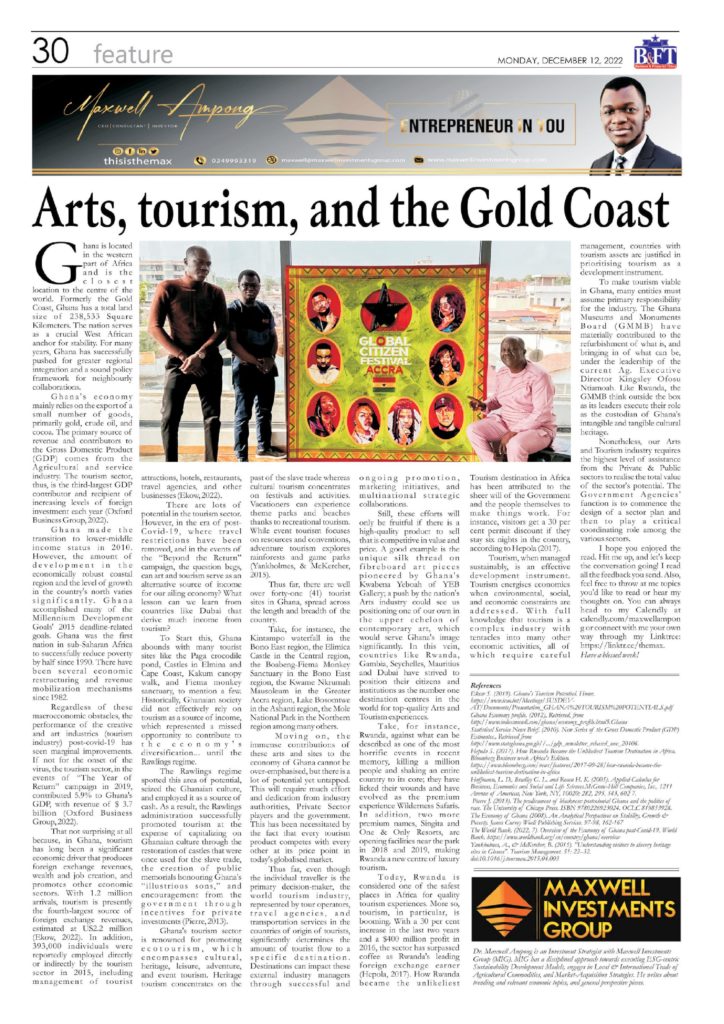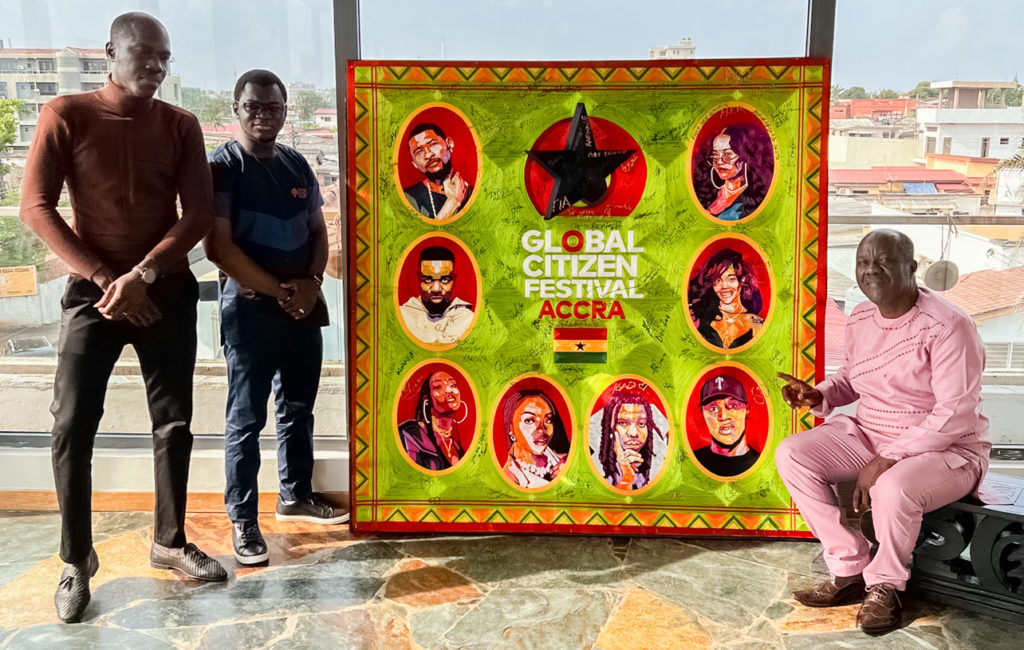
Ghana’s economy mainly relies on the export of a small number of goods, primarily gold, crude oil, and cocoa. The primary source of revenue and contributors to the Gross Domestic Product (GDP) comes from the Agricultural and service industry. The tourism sector, thus, is the third-largest GDP contributor and recipient of increasing levels of foreign investment each year (Oxford Business Group, 2022).
Ghana made the transition to lower-middle income status in 2010. However, the amount of development in the economically robust coastal region and the level of growth in the country’s north varies significantly. Ghana accomplished many of the Millennium Development Goals’ 2015 deadline-related goals. Ghana was the first nation in sub-Saharan Africa to successfully reduce poverty by half since 1990. There have been several economic restructuring and revenue mobilization mechanisms since 1982.
Regardless of these macroeconomic obstacles, the performance of the creative and art industries (tourism industry) post-covid-19 has seen marginal improvements. If not for the onset of the virus, the tourism sector, in the events of “The Year of Return” campaign in 2019, contributed 5.9% to Ghana’s GDP, with revenue of $ 3.7 billion (Oxford Business Group, 2022).
That not surprising at all because, in Ghana, tourism has long been a significant economic driver that produces foreign exchange revenues, wealth and job creation, and promotes other economic sectors. With 1.2 million arrivals, tourism is presently the fourth-largest source of foreign exchange revenues, estimated at US2.2 million (Ekow, 2022). In addition, 393,000 individuals were reportedly employed directly or indirectly by the tourism sector in 2015, including management of tourist attractions, hotels, restaurants, travel agencies, and other businesses (Ekow, 2022).
There are lots of potential in the tourism sector. However, in the era of post-Covid-19, where travel restrictions have been removed, and in the events of the “Beyond the Return” campaign, the question begs, can art and tourism serve as an alternative source of income for our ailing economy? What lesson can we learn from countries like Dubai that derive much income from tourism?
To Start this, Ghana abounds with many tourist sites like the Paga crocodile pond, Castles in Elmina and Cape Coast, Kakum canopy walk, and Fiema monkey sanctuary, to mention a few. Historically, Ghanaian society did not effectively rely on tourism as a source of income, which represented a missed opportunity to contribute to the economy’s diversification… until the Rawlings regime.
The Rawlings regime spotted this area of potential, seized the Ghanaian culture, and employed it as a source of cash. As a result, the Rawlings administration successfully promoted tourism at the expense of capitalizing on Ghanaian culture through the restoration of castles that were once used for the slave trade, the creation of public memorials honouring Ghana’s “illustrious sons,” and encouragement from the government through incentives for private investments (Pierre, 2013).
Ghana’s tourism sector is renowned for promoting ecotourism, which encompasses cultural, heritage, leisure, adventure, and event tourism. Heritage tourism concentrates on the past of the slave trade whereas cultural tourism concentrates on festivals and activities. Vacationers can experience theme parks and beaches thanks to recreational tourism. While event tourism focuses on resources and conventions, adventure tourism explores rainforests and game parks (Yankholmes, & McKercher, 2015).
Thus far, there are well over forty-one (41) tourist sites in Ghana, spread across the length and breadth of the country.
Take, for instance, the Kintampo waterfall in the Bono East region, the Elimica Castle in the Central region, the Boabeng-Fiema Monkey Sanctuary in the Bono East region, the Kwame Nkrumah Mausoleum in the Greater Accra region, Lake Bosomtwe in the Ashanti region, the Mole National Park in the Northern region among many others.
Moving on, the immense contributions of these arts and sites to the economy of Ghana cannot be over-emphasised, but there is a lot of potential yet untapped. This will require much effort and dedication from industry authorities, Private Sector players and the government. This has been necessitated by the fact that every tourism product competes with every other at its price point in today’s globalised market.
Thus far, even though the individual traveller is the primary decision-maker, the world tourism industry, represented by tour operators, travel agencies, and transportation services in the countries of origin of tourists, significantly determines the amount of tourist flow to a specific destination. Destinations can impact these external industry managers through successful and ongoing promotion, marketing initiatives, and multinational strategic collaborations.
Still, these efforts will only be fruitful if there is a high-quality product to sell that is competitive in value and price. A good example is the unique silk thread on fibreboard art pieces pioneered by Ghana’s Kwabena Yeboah of YEB Gallery; a push by the nation’s Arts industry could see us positioning one of our own in the upper echelon of contemporary art, which would serve Ghana’s image significantly. In this vein, countries like Rwanda, Gambia, Seychelles, Mauritius and Dubai have strived to position their citizens and institutions as the number one destination centres in the world for top-quality Arts and Tourism experiences.
Take, for instance, Rwanda, against what can be described as one of the most horrific events in recent memory, killing a million people and shaking an entire country to its core; they have licked their wounds and have evolved as the premium experience Wilderness Safaris. In addition, two more premium names, Singita and One & Only Resorts, are opening facilities near the park in 2018 and 2019, making Rwanda a new centre of luxury tourism.
Today, Rwanda is considered one of the safest places in Africa for quality tourism experiences. More so, tourism, in particular, is booming. With a 30 per cent increase in the last two years and a $400 million profit in 2016, the sector has surpassed coffee as Rwanda’s leading foreign exchange earner (Hepola, 2017). How Rwanda became the unlikeliest Tourism destination in Africa has been attributed to the sheer will of the Government and the people themselves to make things work. For instance, visitors get a 30 per cent permit discount if they stay six nights in the country, according to Hepola (2017).
Tourism, when managed sustainably, is an effective development instrument. Tourism energises economies when environmental, social, and economic constraints are addressed. With full knowledge that tourism is a complex industry with tentacles into many other economic activities, all of which require careful management, countries with tourism assets are justified in prioritising tourism as a development instrument.
To make tourism viable in Ghana, many entities must assume primary responsibility for the industry. The Ghana Museums and Monuments Board (GMMB) have materially contributed to the refurbishment of what is, and bringing in of what can be, under the leadership of the current Ag. Executive Director Kingsley Ofosu Ntiamoah. Like Rwanda, the GMMB think outside the box as its leaders execute their role as the custodian of Ghana’s intangible and tangible cultural heritage.
Nonetheless, our Arts and Tourism industry requires the highest level of assistance from the Private & Public sectors to realise the total value of the sector’s potential. The Government Agencies’ function is to commence the design of a sector plan and then to play a critical coordinating role among the various sectors.
♕ —- ♕ —- ♕ —- ♕ —- ♕
References
Ekow S. (2019). Ghana’s Tourism Potential. Home. https://www.icao.int/Meetings/SUSDEV-AT/Documents/Presentation_GHANA%20TOURISM%20POTENTIALS.pdf
Ghana Economy profile. (2012), Retrieved, from http://www.indexmundi.com/ghana/economy_profile.html5.Ghana
Statistical Service News Brief. (2010). New Series of the Gross Domestic Product (GDP) Estimates., Retrieved from http://www.statsghana.gov.gh//…/gdp_newsletter_rebased_nov_20106.
Hepola S. (2017). How Rwanda Became the Unlikeliest Tourism Destination in Africa. Bloomberg Business week Africa’s Edition. https://www.bloomberg.com/news/features/2017-09-28/how-rwanda-became-the-unlikeliest-tourism-destination-in-africa
Hoffmann, L. D., Bradley G. L. and Rosen H. K. (2005). Applied Calculus for Business, Economics and Social and Life Sciences.McGraw-Hill Companies, Inc., 1211 Avenue of Americas, New York, NY, 10020; 282, 295, 543, 602 7.
Pierre J. (2013). The predicament of blackness: postcolonial Ghana and the politics of race. The University of Chicago Press. ISBN 9780226923024. OCLC 819853928.
The Economy of Ghana (2008). An Analytical Perspectives on Stability, Growth & Poverty. James Currey Woeli Publishing Services. 97-98, 162-167
The World Bank. (2022, 7). Overview of the Economy of Ghana post-Covid-19. World Bank. https://www.worldbank.org/en/country/ghana/overview
Yankholmes, A., & McKercher, B. (2015). “Understanding visitors to slavery heritage sites in Ghana”. Tourism Management. 51: 22–32. doi:10.1016/j.tourman.2015.04.003
♕ —- ♕ —- ♕ —- ♕ —- ♕
I hope you found this article insightful and enjoyable. Subscribe to the ‘Entrepreneur In You’ newsletter here: https://lnkd.in/d-hgCVPy.
I wish you a highly productive and successful week ahead!
♕ —- ♕ —- ♕ —- ♕ —- ♕
Disclaimer: The views, thoughts, and opinions expressed in this article are solely those of the author, Dr. Maxwell Ampong, and do not necessarily reflect the official policy, position, or beliefs of Maxwell Investments Group or any of its affiliates. Any references to policy or regulation reflect the author’s interpretation and are not intended to represent the formal stance of Maxwell Investments Group. This content is provided for informational purposes only and does not constitute legal, financial, or investment advice. Readers should seek independent advice before making any decisions based on this material. Maxwell Investments Group assumes no responsibility or liability for any errors or omissions in the content or for any actions taken based on the information provided.


